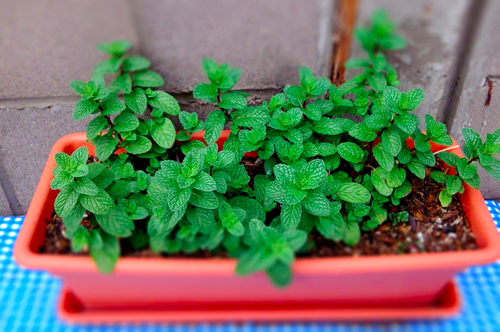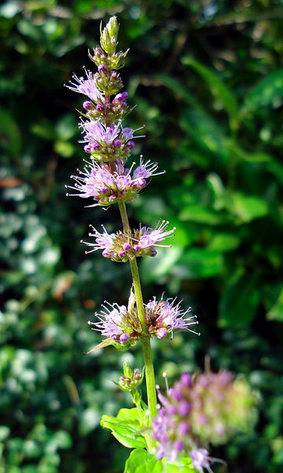
Spearmint (Mentha spicata) is a favourite among the mint family. It is a perennial herb and it is quite hardy. It is an easy herb to maintain.
Spearmint has a rich mint flavour and scent.
Description[edit | edit source]
Spearmint has bright green leaves. The leaves are pointed and somewhat crinkled.
When the plant blooms during summer, it has purple flowers. These flowers attract bees and butterflies (and other beneficial insects and insect pollinators).

Growing spearmint[edit | edit source]
Choose a position with full sun. Spearmint can tolerate some shade.
The soil should be rich and moist; it should be well-drained. Ideal pH of 6.5.[1]
Choose between seed or seedlings for planting. Choose between planting in a container or in the garden bed. Seeds can be sown directly in the ground. Be aware that seeds can be highly variable and you may not get the mint expected.
Cuttings can also be taken to propagate spearmint. Choose runners from healthy mint plants. Keep cuttings moist in soil in a container, allowing the roots to form. Transplant to the final growing place when the root system is established.[1]
Caring for spearmint[edit | edit source]
Cut or mow mint regularly if it is growing in a large amount; this will keep it at its best. To maintain mint in harsh winters, cut it to the ground and mulch.[1]
Divide mint every three to four years, to maintain its vigour.[2]
The more often mint stems are cut, the more it will produce new growth.[2]
Problems[edit | edit source]
As with most mint plants, mint can grow prolifically through underground rhizomes and, as a result, can become invasive.[2] This tendency can be dealt with by either planting it in a large container or planting it in a container without a base (bottomless base) that is buried in the ground to its rim; this helps to prevent the mint from spreading.[2]
In terms of pests, it can be attacked by spider mites, root borers, grasshoppers, cutworms, root weevils, aphids and loopers.[1]
In terms of disease, it can be affected by verticillium wilt, mint rust and mint anthracanose.[1]
Uses for spearmint[edit | edit source]
Spearmint has culinary, aromatic, cosmetic and medicinal uses.[1]
If using the leaves for drying, pick the leaves prior to flowering. If the flowers are not removed, the flavour in the leaves is considerably reduced. This also applies to leaves to be used fresh.[2]
For culinary purposes, spearmint can be added to various meat dishes, sauces, beverages, preserves such as jellies and jams and sweets.